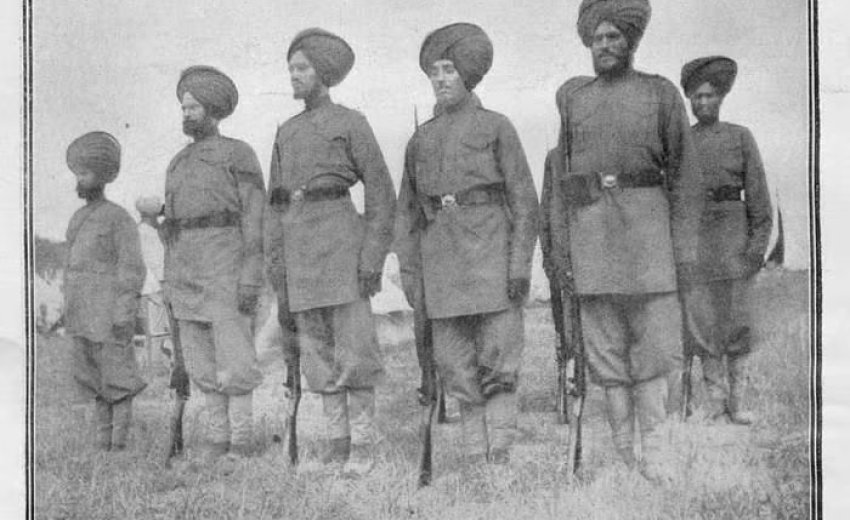Dongtai Lu in Shanghai is renowned for its bustling antique market. Stalls are packed with vintage curios, memorabilia of Chairman Mao, and postcards depicting scenes of Old Shanghai. During a visit, vendors eagerly showcased antiques, sensing an interest in the era when Shanghai was a vibrant hub dominated by Westerners due to the unequal treaties of the Opium Wars in the mid-1800s.
Meena Vathyam, an author, came across photographs that could help piece together the forgotten lives of Sikhs who lived in Shanghai for over half a century, beginning in 1884. The author’s fascination with Sikhs in Shanghai began in 2010. As an expatriate in the city, the author stumbled upon a local guidebook. Inside was a picture of a Sikh Gurudwara, a relic from the days of Old Shanghai. This discovery sparked a deep interest in uncovering the stories of the Sikh community that once thrived there.
History of Sikhs in Shanghai
The history of Shanghai is marked by significant upheaval. During its time as a treaty port, the city was divided into various foreign enclaves, each operating under its own set of judicial, economic, and political laws, as well as distinct postal systems. In contrast, the Chinese residents lived in the walled parts of the city, often in very poor conditions.
One prominent area within Shanghai was the International Settlement, primarily a British zone with a notable American presence. This area was governed by the Shanghai Municipal Council (SMC), an administrative body made up of officials elected by taxpayers. The SMC was also responsible for maintaining security in the International Settlement through the Shanghai Municipal Police.
Starting in 1884, the Shanghai Municipal Police began to recruit Sikh men from British India to manage the chaotic traffic intersections. Dressed in khakis during the summer and heavy, dark coats in the winter, the Sikhs were a striking presence. Their tall stature, bushy beards, and red turbans added a distinctive and picturesque element to the cosmopolitan atmosphere of Shanghai.
Sikhs becoming part of the Shanghai community
In addition to securing jobs as policemen, many Sikhs in China also worked as watchmen and supplemented their income by working as moneylenders. Indian Sikhs were often recruited into the British police force, serving in various Chinese cities including Tientsin (now Tianjin), Amoy (now Xiamen), and Hankow (now part of Wuhan).
The author had to sift through numerous stacks ,when visiting the stalls of the Dongtai Lu vendors to find photo postcards of Sikh policemen. In the perception of the Chinese, the Sikh policeman symbolized the oppressive British imperialism, earning them the derogatory nickname Hong-Tou-A-san, meaning "turbaned number three." This nickname reflected their perceived low status in the social hierarchy of that era.
Despite their prominent and smart appearance, the stories of Sikh policemen in Shanghai and other parts of China remain largely untold. As symbolic representatives of the British Empire in several of its colonies, Sikh policemen have been marginalized in historical records. Today, a dilapidated Gurudwara, more than a century old, stands as one of the few remaining testaments to their presence in China. During that time, the Sikhs in Shanghai were ardent supporters of the Ghadr Party's struggle for Indian independence and Subhas Chandra Bose's Indian National Army.
Sikhs were not the only Indians who lived in Old Shanghai. Parsi opium traders also found significant financial success in the city. The stories Dr. Cavas Lalkaka, who was accidentally shot in 1909 in London by freedom fighter Madan Lal Dhingra, and the journeys of photojournalist Sam Tata, are less well known. In contrast, the exploits of notable figures like Jamshetji Jejeebhoy, the Readymoneys, and the Wadias, who used the profits from their opium trade in China to fund infrastructure projects in Mumbai, are more widely recognized.
Shanghai even had a Parsi agiary (fire temple), indicating the presence and religious practices of the Parsi community. The city was also home to other Indian communities, including Punjabi Muslims, Ismaili merchants, Gurkhas, and Sindhis. Unfortunately, these diverse groups were often misclassified as Sikhs due to general misconceptions.
The Sikh community
Several incidents thrust the Indian community in Shanghai into the spotlight, offering glimpses into the vibrant and often scandalous life hidden beneath the dry official narratives. After all, this was Old Shanghai, known as the "Paris of the East" and a notorious city of sin.
Atma Singh, a Sikh policeman attained notoriety in 1936 for the murder of another Sikh who had insulted his wife. Sentenced to death, Atma Singh's story took a dramatic turn when the rope used for his execution broke while he was on the gallows. This mishap made headlines worldwide and many of his compatriots viewed his survival as a miraculous event, revering him as a holy man. Eventually, his death sentence was commuted to life imprisonment.
In the early 1940s, the Shanghai social scene was electrified by Princess Sumaire of Patiala. A cousin of the renowned painter Amrita Sher-gill, Princess Sumaire was also a notorious scam artist. Known for her extravagant lifestyle, she was a bigamist who mingled in various high-society circles, often flaunting her wealth and fashion. A British police official investigating her background labeled her a nymphomaniac and a lesbian. During the Japanese occupation of Shanghai, she collaborated with the occupying forces and married a Japanese-American without divorcing her first husband in India.
By 1949, the majority of Indians had left Communist China, relocating to their homeland, Hong Kong, or other destinations in the West. Their departure left only faint traces of their presence in China. There remains a hope to delve into archives and uncover the fascinating, yet still largely unexplored, stories of the Indians in Old Shanghai.
*Based on an article by Meena Vathyam, published in Scroll.in on 17th April 2014

